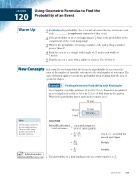Page 832 - Algebra 1
P. 832
L E S S O N Using Geometric Formulas to Find the
120
Probability of an Event
Warm Up
1. Vocabulary In probability, the set of all outcomes that are not in an event
(14)
is the (complement, converse) of that event.
2. If the probability of an event happening is _3 what is the probability of the (14) 4
complement of the event happening?
3. What is the probability of tossing a number cube and getting a number
(14)
greater than 4?
4. Find the area of a rectangle with length of 25 inches and width of
(16)
5 inches.
5. Find the area of a circle with a radius of 2 inches. Use 3.14 for π.
(16)
New Concepts In Lesson 14, you learned that the theorectical probability of an event is the ratio of the number of favorable outcomes to the total number of outcomes. The
same definition applies to geometric probability when working with the area of geometric shapes.
Finding Geometric Probability with Rectangles
A rectangular vegetable garden is 10 feet by 15 feet. Tomatoes are planted in a rectangular area that is 3 feet by 12 feet. A bird lands in the garden. What is the probability that it lands in the tomato area?
Example
1
15 feet
favorable outcomes = area with tomatoes _ _ _ _
10 feet 3 feet
Hint
The favorable outcome is the area with tomatoes. The area of the entire garden represents all possible outcomes.
SOLUTION
total outcomes area of entire garden = 3 · 12
Use A = l · w to find the area of each figure.
Multiply.
Simplify.
10 · 15 = 36
_ 150
= _6 25
12 feet
Tomatoes
Online Connection www.SaxonMathResources.com
_6 The probability of a bird landing in the area with tomatoes is 25 .
Lesson 120 817


